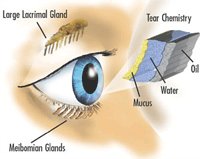
Dry Eye Syndrome: What is it?
Symptoms You May Experience:
Examination: What Your Eye Doctor Will Look For:
What You Can Do:
When To Call Your M.D.:
Treatment:
Prognosis: Will I See Better?
Dry eye syndrome is an extremely common condition in which the tear film that lubricates the surface of the eye is abnormal. It is usually due to one of two causes: decreased tear production or increased tear evaporation. Common causes of decreased tear production include Sjogren's syndrome (an autoimmune disorder in which the lacrimal gland is disfunctional) lacrimal gland disease, and decreased corneal sensation. Common causes of excessive tear evaporation include blepharitis (in which the oil glands around the eyelashes are clogged), blink problems, and eyelid closing problems. Other causes of dry eye syndrome include systemic diseases (sarcoidosis, human immunodeficiency virus, multiple sclerosis, lymphoma, Stevens-Johnson syndrome, and vitamin A deficiency), certain medications (antihistamines, decongestants, blood pressure medication, and
You may experience a burning sensation in the eye, dryness, the feeling that something is in the eye, blurry vision, and sensitivity to light. These symptoms are often worse at the end of the day or after prolonged use of the eyes.
The eye doctor may see redness or swelling on the white of the eye, decreased tear film, debris in the tear film, an irregular surface of the cornea, or a poor blink response. He or she may put an eye drop in your eyes to check for certain staining patterns on your cornea or conjunctiva. In more severe cases, the doctor may find filaments and mucous plaques. These can become quite painful. In extremely severe cases, your cornea can become thin or, rarely, even perforate.
You can reduce your chances of dry eyes by avoiding medications that can cause dry eyes, such as antihistamines and decongestants, and by decreasing the amount of time you wear contact lenses.
If you are experiencing persistant burning and dryness or any decrease in vision, redness, severe pain, or a white spot on the normally clear front surface of your eye, you should contact your eye doctor immediately. Certain causes of dry eyes can lead to an increased risk of infectious keratitis.
For mild dry eyes, treatment consists of over-the-counter, preservative-free artificial tear drops, administered up to four times a day, and lubricating ointment at night. If your eyes are moderately dry, you can use preservative-free artificial tear drops up to every hour if needed, as well as ointment at night. Your ophthalmologist may place plugs in your tear ducts so that tears will last longer in your eyes. If you have severe symptoms, you can use these treatments as well as make your environment more moist with a humidifier. Other possibilities include surgery to partially close the eyelid (partial tarsorraphy) or, rarely, a specialized contact lens.
Most patients do well with conservative management, such as by using artificial tears and lubricating ointment.

Above: Dry Eye Syndrome Has Many Causes.
Contact Lenses | Glaucoma | Just For Fun | Eyeglasses | Eye Doctor | Eye Care And Symptoms | Eye Anatomy | Online Eye Tests | Laser Eye Surgery | Laser Eye Surgery Directory: Canada | Laser Eye Surgery Directory: USA | Laser Eye Surgery Reviews | Submit A Review | Contact Us | Privacy Policy | Sitemap
Copyright 2006-2009 Vision Health
antipsychotic agents) glaucoma eye drops, and prolonged wearing of contact lenses. Postmenopausal women may be especially prone to developing dry eye syndrome. Most cases of dry eye syndrome are not associated with a general medical disease or serious eye problem.

